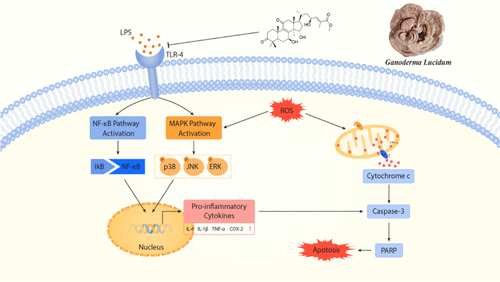当前位置:
X-MOL 学术
›
J. Agric. Food Chem.
›
论文详情
Our official English website, www.x-mol.net, welcomes your
feedback! (Note: you will need to create a separate account there.)
Ganoderterpene A, a New Triterpenoid from Ganoderma lucidum, Attenuates LPS-Induced Inflammation and Apoptosis via Suppressing MAPK and TLR-4/NF-κB Pathways in BV-2 Cells
Journal of Agricultural and Food Chemistry ( IF 5.7 ) Pub Date : 2021-10-20 , DOI: 10.1021/acs.jafc.1c04905 Rong-Wei Kou 1 , Yu-Qi Gao 1 , Bing Xia 2 , Jia-Yun Wang 1 , Xiao-Ning Liu 2 , Jiang-Jiang Tang 1 , Xia Yin 1 , Jin-Ming Gao 1
Journal of Agricultural and Food Chemistry ( IF 5.7 ) Pub Date : 2021-10-20 , DOI: 10.1021/acs.jafc.1c04905 Rong-Wei Kou 1 , Yu-Qi Gao 1 , Bing Xia 2 , Jia-Yun Wang 1 , Xiao-Ning Liu 2 , Jiang-Jiang Tang 1 , Xia Yin 1 , Jin-Ming Gao 1
Affiliation

|
An investigation of the fruiting bodies of edible mushroom Ganoderma lucidum produced 13 steroids, containing one new lanostane-type triterpene compound, named ganoderterpene A (1). Nuclear magnetic resonance and high-resolution electrospray ionization mass spectrometry data were used to deduce these structures. All the isolates were evaluated for their ability to suppress NO generation in BV-2 microglial cells treated with lipopolysaccharide (LPS) and exhibited moderate to strong inhibition effects, with IC50 values in the range 7.15–36.88 μM. Among the tested compounds, compound 1 exhibited the most marked activity with an IC50 value of 7.15 μM, and the structure–activity relationships were studied. This study showed that compound 1 significantly suppressed the activation of MAPK and TLR-4/NF-κB signaling pathways, as evidenced by an immunofluorescence assay and a molecular docking experiment. Furthermore, compound 1 effectively improved the LPS-induced mitochondrial membrane potential and apoptosis. These findings suggest that ganoderterpene A could exert protective effects in microglial cells from apoptosis by restraining the inflammatory response. Hence, G. lucidum could be used as a novel preventative agent for neurodegenerative disorders.
中文翻译:

Ganoderterpene A,一种来自灵芝的新三萜,通过抑制 BV-2 细胞中的 MAPK 和 TLR-4/NF-κB 通路减弱 LPS 诱导的炎症和细胞凋亡
一项对食用菌灵芝子实体的研究产生了 13 种类固醇,其中含有一种新的羊毛脂烷型三萜化合物,命名为灵芝 A ( 1 )。核磁共振和高分辨率电喷雾电离质谱数据用于推断这些结构。评估了所有分离株抑制脂多糖 (LPS) 处理的 BV-2 小胶质细胞中 NO 生成的能力,并表现出中到强的抑制作用,IC 50值在 7.15–36.88 μ M范围内。在测试的化合物中,化合物1表现出最显着的活性,IC 50值为 7.15 μM,并研究了构效关系。这项研究表明,化合物1显着抑制了 MAPK 和 TLR-4/NF-κB 信号通路的激活,免疫荧光测定和分子对接实验证明了这一点。此外,化合物1有效地改善了LPS诱导的线粒体膜电位和细胞凋亡。这些发现表明,灵芝萜烯 A 可以通过抑制炎症反应对小胶质细胞发挥保护作用,使其免于凋亡。因此,灵芝可用作神经退行性疾病的新型预防剂。
更新日期:2021-11-03
中文翻译:

Ganoderterpene A,一种来自灵芝的新三萜,通过抑制 BV-2 细胞中的 MAPK 和 TLR-4/NF-κB 通路减弱 LPS 诱导的炎症和细胞凋亡
一项对食用菌灵芝子实体的研究产生了 13 种类固醇,其中含有一种新的羊毛脂烷型三萜化合物,命名为灵芝 A ( 1 )。核磁共振和高分辨率电喷雾电离质谱数据用于推断这些结构。评估了所有分离株抑制脂多糖 (LPS) 处理的 BV-2 小胶质细胞中 NO 生成的能力,并表现出中到强的抑制作用,IC 50值在 7.15–36.88 μ M范围内。在测试的化合物中,化合物1表现出最显着的活性,IC 50值为 7.15 μM,并研究了构效关系。这项研究表明,化合物1显着抑制了 MAPK 和 TLR-4/NF-κB 信号通路的激活,免疫荧光测定和分子对接实验证明了这一点。此外,化合物1有效地改善了LPS诱导的线粒体膜电位和细胞凋亡。这些发现表明,灵芝萜烯 A 可以通过抑制炎症反应对小胶质细胞发挥保护作用,使其免于凋亡。因此,灵芝可用作神经退行性疾病的新型预防剂。











































 京公网安备 11010802027423号
京公网安备 11010802027423号